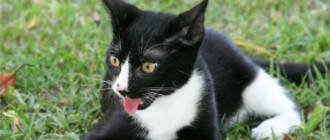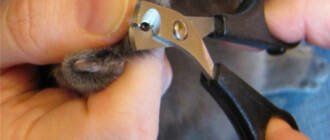As of today, 73 cat breeds are registered in TICA, 45 in CFA, and 48 in FIFe (as of 2019). At the same time, every few years breeders announce new whiskers for vacancies in the felinological systems. How not to get lost in the variety of feline types and establish the breed of an animal without resorting to the services of a professional felinologist? Why isn't its exterior and good-natured character enough for recognition of a cat's pedigree? How to insure yourself against deception, buying a purebred kitten allegedly without documentation? To these and other questions related to the breeds of cats, we answer in the following article.
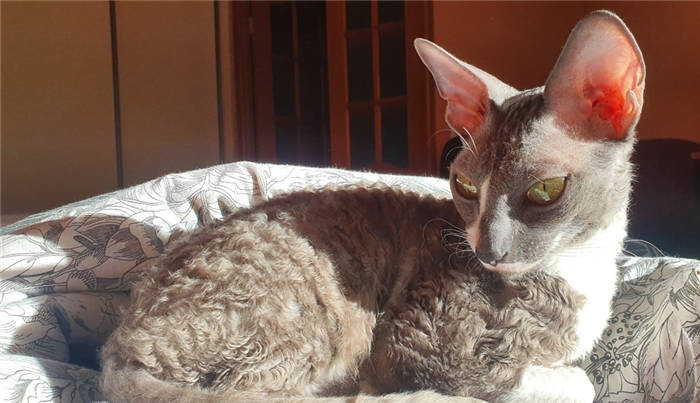
- Pedigree breeding
- Breed, as it is defined
- Cat breeds
- What cats are considered as purebred, and which ones are pedigree and how it is defined.
- How to determine the breed of cat?
- Why do I need a pedigree?
- How to identify the breed yourself
- Hair type.
- Color
- Noble bloodlines and their untitled relatives: How to find out which clan your pet belongs to
- Determining a cat's breed by physical characteristics
- Siamese Color/Color Point
- According to character.
- How to know the breed of cat by hair color
- Siamese
- How to determine a kitten's breed
Pedigree breeding
Generally, breeding (or selection) aimed at fixing certain features, which we define the breed of cat. For example, Bengals – bright appearance, color… Can't be confused. Or the Persian is a fluffy, snub-nosed cloud…
In order to have such traits in the offspring, cats and cats of such appearance are crossed. And then the kittens who best match the breed traits go for breeding.
So we know who the kitten's ancestors are, pedigree cats have a pedigree. The pedigree records all of a kitten's ancestors up to the 4th (or even 5th) tribe, specifying their breed and color.
Breed, as it is defined
We look at the pedigree, we see the breed of ancestors, and we know that the kitten belongs to that breed. We look at it – yes, exactly)))
Because a cat can have all sorts of different traits in its genes, of different breeds. Some kitten may be born similar to a certain breed. But it could have anything in its genes. And a cat that looks like a British cat can give birth to kittens that look completely different…
In the case of a purebred cat this does not happen, if we breed a purebred cat and the same breed of cat, we will get kittens of the same appearance, there will be no scatter on the traits.
For example, when I was a kid, I had a cat named Lisa, with an appearance similar to Siberian. And she birthed kittens of all kinds, once she gave birth to such a kitten, that looked like a Brit… In one litter were kittens of different colors and sizes… The cat was a "non-breed", but her appearance was similar to the breed.
Cat breeds
Each breed is defined by specific features in appearance and character traits peculiar only to it – it is called a breed standard, which must be recognized by various organizations of felinologists (TICA, FIFe, WCF, CFA, IFA, ICU, WACC, etc.), each of which has its own rules of recognition. All pedigree cats are given pedigree certificates.

One of the most amazing and mysterious breeds is Maine Coon – affectionate giant with a serious look. These creatures are called "house lynxes," which is not surprising, since they are one of the largest domestic cats.
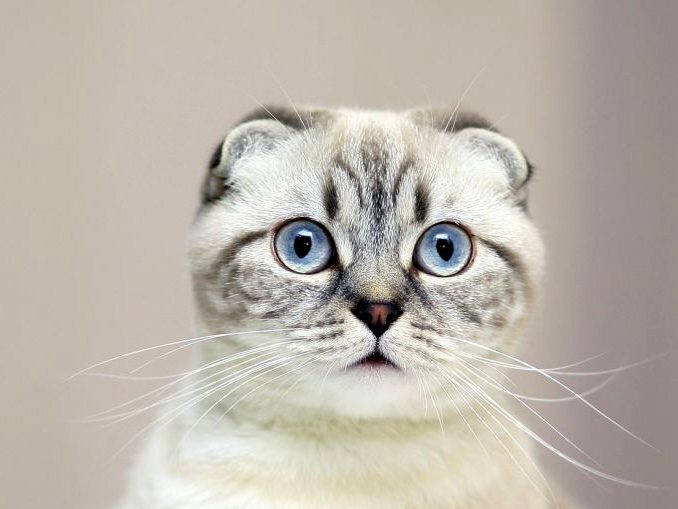
All over the world this breed is called "Scottish Fold", but we are more accustomed to calling these cute cats "Scottish lop-Eared". Their "cute" appearance will not leave anyone indifferent – this creature immediately want to take the hands and cuddle.
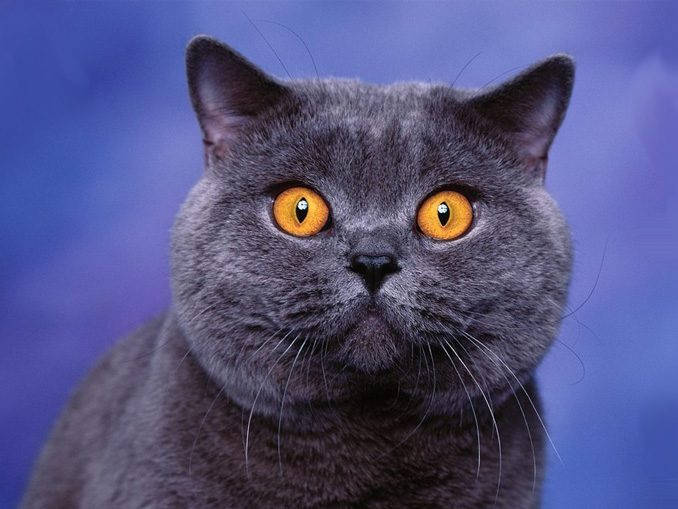
Without these "soft" lumps of happiness, millions of people all over the world can't imagine their existence. These aristocratic, friendly, charismatic, and very clean pets have long been one of the most popular cat breeds in the world.
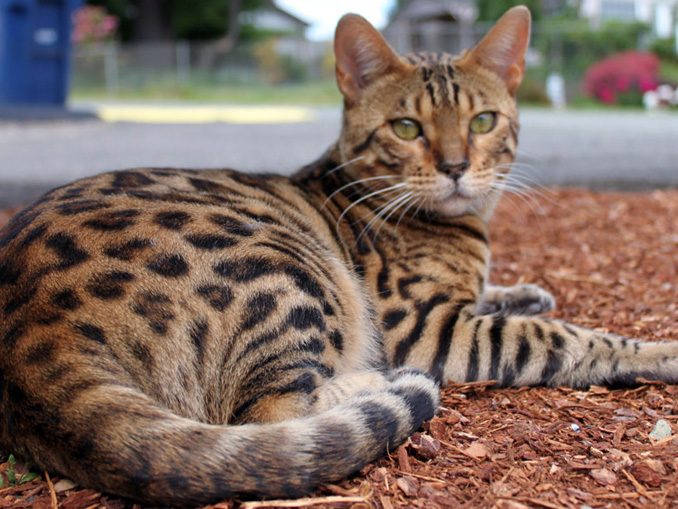
Bengal cats are incredibly beautiful animals, which combine the spectacular appearance of wild predators and compliant nature of pets. Well, the main "chip" of these creatures is the "leopard color", for which they are called "pet leopards.

What cats are considered as purebred, and which ones are pedigree and how it is defined.
Owners of a kitten or an adult cat without documents confirming the animal's breed affiliation very often think about defining the breed and fixing it with official documents. This should allow the animal to become a producer of kittens and become a member of exhibitions, which allows, in addition to all attracting additional income.
However, if the documents were not issued to the kitten in the cattery, it is impossible to get it. It does not matter, that "by eye" you can accurately determine that the cat belongs to a certain breed. The fact is that without a pedigree the animal will be considered a purebred in any case. Pedigree is issued by the felinology club and confirms that the kitten meets the standards of a certain breed. To know exactly how to proceed in this situation, you should read the instructions below.
1. Buying a kitten in a cattery, the owner will be absolutely sure of the origin of his pet. A cat's breed is defined by a number of traits characteristic of the genus. This includes the animal's behavioral features and exterior traits. Along with the kitten, documents will be attached, which record the pedigree with the names of three generations, the breed and color features.
2. If a kitten or an adult cat does not have a pedigree, then the animal will be considered a pedigree, even if it has a color characteristic of a certain breed. You can purchase a cat atlas in bookstores which will show the exterior of typical members of each breed in the feline family.
It is not possible to determine the breed of a kitten who has no documents, because the color of the coat may change with age. For example, the Nevsky Masquerade breed kittens are born almost always white and only with age their coat becomes darker.
4. Only experts can accurately determine the breed of the animal. To do this, it is enough to take close-up photos of paws, ears and tail. Based on these photos of the cat's exterior, a professional will put an end to the question of whether the cat belongs to a particular breed.
How to determine the breed of cat?
Such questions are often asked by owners of a cat that they believe is a purebred. But is it really so?
Please do not be offended or upset. Any cat without documents is good.
BUT! There are subtleties and laws, which you should know, so that you would not be hurt and offended later…
Actually, a BREEDED kitten is a kitten that you were given papers for. The documents are the kitten's certificate, where the club, cattery, where he was born, parents, their names, breed and colors are written. And also the kitten's class is listed – brid or pet. Brid – that means that the kitten is recommended for breeding, and pet – for pet.
Usually normal breeders sell a kitten as a pet already neutered.
The kitten's certificate can then be exchanged at that club (its contacts are listed in the certificate) for a pedigree.
The pedigree specifies the system by which the cattery, cattery, club, cat breeder and owner work, and describes 4 or 5 generations of a cat's ancestors, specifying the breed and color. In the pedigree with the admission for breeding, the pedigree numbers of all the ancestors are also written.
This is very important to understand, because a pedigree like on the picture – it does not guarantee that the cat is a purebred. If there are no numbers of ancestors, such pedigree can be given to a neuter. But not a pedigree cat or a cat.
Why do I need a pedigree?
When planning a mating, the breeder examines the pedigrees of the intended pair to obtain offspring that best meet breed standards, or the breeder's plans. Maybe he wants a certain color of kittens, or the quality of the coat, whatever!
A purebred kitten also necessarily has a veterinary certificate. It notes all of the kitten's worming treatments, date. Vaccinations, stickers and date, and the stamp of the veterinary clinic. You can get the passport for any cat, though from the street, the form itself costs pennies, you can buy at any veterinary clinic. But a purebred kitten from a cattery must have a veterinary passport! A purebred kitten from a cattery is usually sold with double vaccination against various diseases, and single vaccination against rabies. And it must be some time – 2 weeks or a month – from the date of the last vaccination. Then the kitten can safely travel around the country and the world. He is already protected from disease and will not pick up anything on the road.
Also, usually the breeder sells his kitten under contract. Where he indicates the rights of the buyer, describes the conditions of the sale of the kitten, and contacts of the breeder and the buyer.
So when you buy a kitten on Avito, and you're told that with the documents the kitten will cost two or three times more expensive – do not believe it, it's a trick!
The documents cost kopecks. Kitten's registration card costs from 200 to 500 rubles, veterinary passport – 50 rubles.
And if you want to do breeding, you need to buy a cat from a breeder, with documents and admission to breeding, you need to find a club and join it, and start training to have an idea of your breed and the rules of working with it.
Without documents the cat, no matter what breed it looks like, is still not a purebred. And it's best not to use it for breeding.
- Kittens without documents are sold for pennies, and even for free no one takes.
- The health of the cat and kittens is under great question, since you do not know who her ancestors were. And problems during pregnancy and childbirth are quite possible…
- It's just irresponsible to breed kittens who will then easily end up on the street and add to the already unrealistically huge population of homeless animals in the country… They themselves, if they are not similar to the breed they are passed off as… Or their offspring.
How to identify the breed yourself
Even if you managed to identify the breed group and type of physique of the pet, it is still too early to make unambiguous conclusions about the breed. It is necessary to study his appearance in detail, especially paying attention to the following traits.
Hair type.
In addition to the difference in length, the coat of cats differs in its structure:
- "Plush" – Puffy hair combines with well-developed undercoat, giving the coat more softness and making it tactilely pleasant (British Shorthair, Scottish Fold, Exot etc.).
- Hard-haired type. – Thick, elastic and prickly to the touch hair. It is extremely rare (at the moment only in the American hardcoat).
- Curly or wavy hair – forms curls or curls (Cornish Rex, Devon Rex, Selkirk Rex and others).
Pets with hair length up to 10 mm are generally considered hairless: they include Canadian and Don Sphynx, Peterbald, Bambino, Dwelford etc.
Color
On belonging to a particular breed can also say its color. Of course, among them there are many popular shades (e.g., black, white, red), which will not allow to come close to unraveling. But there are some that belong to few breeds:
- Blue – Only the British (short-haired and long-haired), Scottish (straight-eared and lop-eared), Russian blue, chartreuse, korat, and nibelung can boast of this color coat.
- Chocolate – A deep brown shade of hair of Havana, Burma and Chantilly-Tiffany.
- Color-point – is considered a classical "Siamese" color and is characteristic for cats from South-East Asia and hybrids created with their participation: Siamese, Thai, Burmese, Himalayan, Balinese, Tonkin, Nevskaya Masquerade, Skiff-Toy-Boba, Snow Shoe.
- Sandy – A rare coat color typical of Abyssinian and Somali cats.
- Tabby – Also called "wild" because it is closest to the natural color of the historical ancestor of all domestic cats. Characteristic spots and stripes can be found in Egyptian Mau, Bengal, Siberian, Tooger, Serengeti, Caracet and others.
- Chinchilla – A rare combination of white color with silvery or golden flecks. It is peculiar to only three breeds: British, Scottish and Siberian.
Noble bloodlines and their untitled relatives: How to find out which clan your pet belongs to
Pedigree cats and their mongrels differ from each other not only by appearance and habits, but also by documents. That is why if one day you decide to take in a stray Persian with show exterior, keep in mind that you will not "go to exhibitions". Moreover, without documents confirming cat "personality" even the purest purr-furred cat automatically becomes invisible for felinological systems.
For closed breeds (when animals within a breed group are mated) a pedigree, feline ID card and veterinary passport are mandatory. In situations with open, in-progress breeds (when mating with other phenotypic individuals is allowed), the final verdict is rendered by the breeding expert.
Important: A cat's membership in an open breed is confirmed if the undocumented animal receives an "excellent" rating for exterior characteristics from three judges. As a result, an individual is recognized as a pedigree cat and receives a pedigree pedigree certificate without ancestors in the appropriate box.
Determining a cat's breed by physical characteristics
So, with cats with a package of necessary documents on their paws, sorted out. But what to do, if you have an adorable "podobrash" or an orphan cat, whose origin is a mystery? First of all, love the purr and provide him with comfortable living conditions. Well, if you still want to find out who is listed as an ancestor of your ward, it is enough to look closely at its appearance.
If you have a black or red "matroskin," feel free to skip this and subsequent paragraphs and proceed to read the next block, because such cats are found in the vast majority of breeds. Well, for owners of cats with "coats" of other shades there is a little useful information.
Siamese Color/Color Point
Distinctive features: light hair on the body + shaded muzzle, ears, paws and tail, as a consequence of acromelanism (incomplete albinism). Breeds of cats standard of which this type of color is fixed: Siamese, Burmese shorthair, Thai, Seychelles shorthair, Munchkin, Peterbald, British, Scottish, Laperman, European shorthair, Don and Canadian Sphynx, Devon Rex, Balinese, Burma.
According to character.
The last method is character accounting, but felinologists note that it is the most unreliable. The behavior of any animal is shaped as it matures. In addition to genes, it is influenced by various external factors, including housing conditions. Pets raised in a caring family are calmer, gentler, and more talkative regardless of breed. Despite this, the breed standard still fixes certain behavioral traits on a cat.
- Choleric (Bengal, Oriental, Sphynx). Incredibly active type, loving games and walks. Not inclined to hold back emotions.
- Melancholic (Siamese). Very sensitive and resentful. Needs a lot of attention and patience.
- Sanguine (ragdoll, Maine Coon, Neva Masquerade). The most quiet and reserved type. Ideal for families with children. Relaxed to loneliness, but also not against the company. Not afraid to go into contact with strangers.
- Phlegmatic (Persian, British). Also very calm type, but more inhibited. Does not hurry to take the initiative and can meditate for hours in one pose, without distraction to external stimuli.
Please note that this division is relative. The same Siamese cats may well be the soul of the company, if you don't hurt their feelings and listen to their desires.
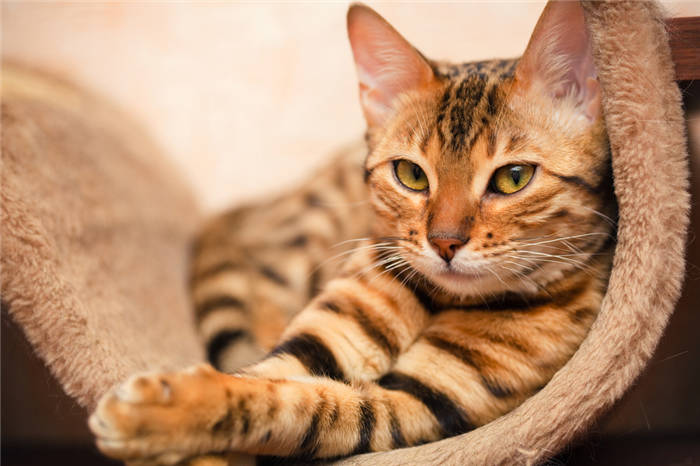
Determination of cat breed without documents is more like a fun game, where you can confirm or refute your guess. If you're serious about it, try a DNA test. It establishes breed identity at the genetic level, which minimizes the chance of error. The problem is that few veterinary clinics provide such service, and only really popular and widespread breeds can be found among samples for comparison.
How to know the breed of cat by hair color
Very often it is possible to distinguish a purebred aristocratic cat from an ordinary murky cat by its color. Domestic cats are usually rather uncomplicated, two or three colors, with large spots or stripes.
On the same coloring of pedigree animals thoroughly worked experts. Sometimes this characteristic can identify the specific breed of kitten immediately.
Siamese
The Siamese color, also called color-point, is characterized by darker spots on the cat's face, ears, legs and tail.
Initially, only Thai or Siamese cats could boast of this coloring, but over time, breeders have given this coloring to many breeds:
- Balinese;
- British;
- Neva Masquerade;
- Himalayan;
- Burmese;
- Persian;
- ragdoll, etc.

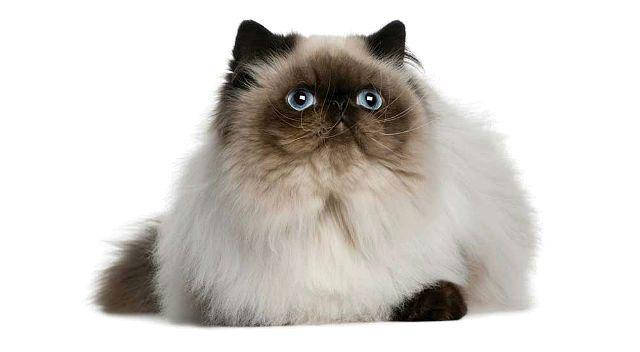
The Siamese group also includes the color snow shoe. On the muzzle of a kitten, there is a distinctive snow-white marking in the form of a bird, and white socks on her paws.
There are several varieties of point colors in cats depending on the color contrast and smoothness of the transition from dark to light:
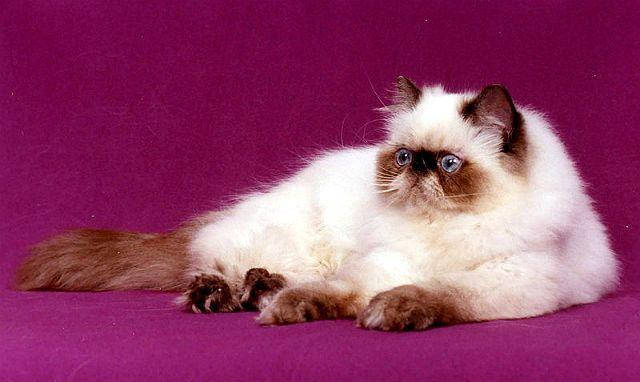
- power point – soft cream;
- blue point – silver-blue;
- Chocolate point – brownish-chocolate;
- Lilac Point – pinkish-blue;
- Red Point – pronounced apricot (red);
- cream-point – tender beige and amber;
- Caramel- point – grayish beige;
- Cinnamon Point – reddish-brown;
- Fawn Point – pale cream.
How to determine a kitten's breed
Determining the breed of a young kitten is extremely difficult. Some babies change a lot as they grow up. Not only the structure and length of the coat may change, but also the color of the eyes.
Lop-eared kittens are often born with normal straight ears, which only drop down after a few months.
At 3-4 months of age, the kitten becomes more like its parents. But the final exterior of the cat will be formed only closer to one year.
Even if the whole kitten meets all the standards of the breed, without having his official documents for exhibition and breeding activities, it is not allowed. No expert has the right to determine its breed on paper, not having data (documented) on the parent pair.
In principle, unofficially, it is possible to determine the breed of a cat not burdened with personal documentation. The kitten's appearance will tell you everything about him. You just have to take a good look at your own pet.



